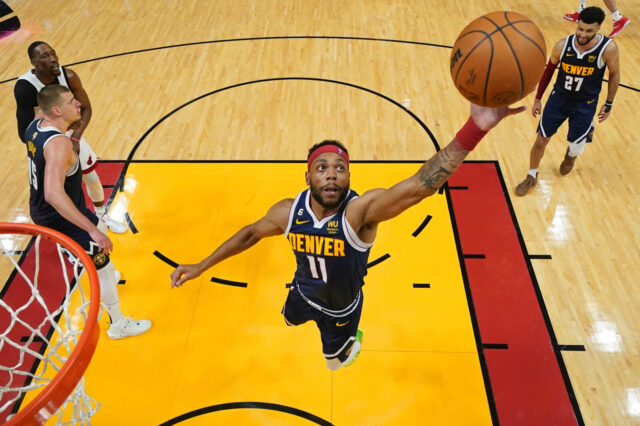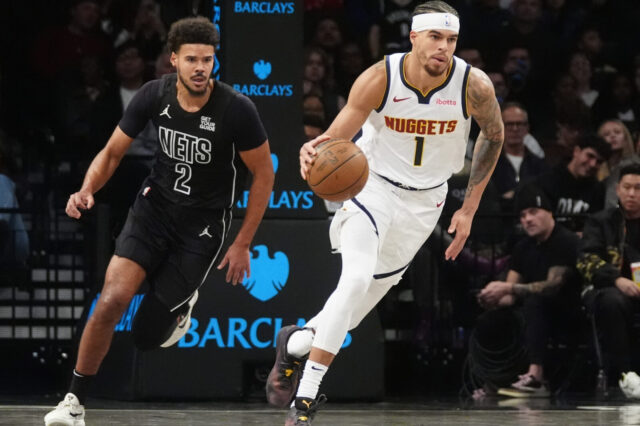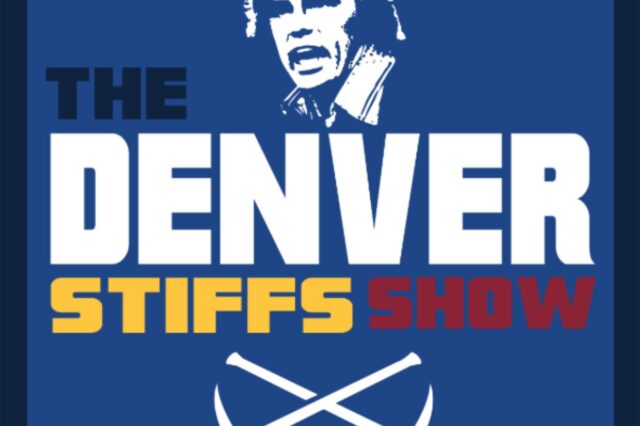During this edition of Stat of the Week, the focus is on the Denver Nuggets guards and how they score the basketball.
Play type data has improved rapidly over the years and allows the opportunity to break down scoring possessions involving different motions, finishes, and circumstances. For the Nuggets guards, how they score is almost as important as whether they score. Denver’s offense is designed to help the team remain as efficient as possible, and the play type data illustrates that.
Here’s the breakdown for six Nuggets guards and wings from last season, including Isaiah Thomas during his time with the Cleveland Cavaliers and the Los Angeles Lakers:
This content is no longer available.
Jamal Murray
Denver’s starting point guard scored most frequently in a pick and roll setting, primarily with Nikola Jokic last season. Jokic ranked 5th in the entire NBA in screen assists per game with 4.3, and Murray had many opportunities to capitalize on that with open shots.
The threat of Jokic’s screen also makes things difficult on the defense, and Murray will reject the screen from time to time, getting all the way to the rim on this occasion.
Murray’s points per possession in pick and roll scoring was a steady 0.86 ppp, 63rd percentile in the NBA and an excellent mark for a 20-year-old. As he becomes more comfortable creating his shot at the NBA level, that number has to trend closer to 1.00. Stephen Curry, Kyrie Irving, and Damian Lillard lead the league at 1.13, 1.10, and 1.05 ppp respectively, and if opposing defenses have to treat Murray in a similar light, Denver’s offense goes from explosive to nuclear.
Gary Harris
Harris experienced a minor shift in his frequency data from 2016-17 to 2017-18.
This content is no longer available.
Minor variations occurred in most play types, but the two most interesting were a decrease in cuts and an increase in hand offs. Jokic burst onto the scene in 2016-17 with his amazing passing and scoring efficiency, and Harris was the first Nugget to truly take advantage, committing to the back cut. Harris averaged 1.39 ppp and was one of the best guards in the NBA cutting to the basket in 2016-17.
So, why the change? The primary reason for this was the opponent’s defense adjusting to what Denver was doing. Instead of this:
This content is no longer available.
Denver received this nightly.
Notice the eyes trained on the Harris-Jokic two-man game and the way Kemba Walker stops to contest the layup. Charlotte, a well-coached defense, knew exactly what was coming. Only an excellent pass and sublime finish could make this work.
Instead, the Nuggets two-man game between Harris and Jokic has turned into primarily a hand off action, hence Harris having the highest hand off frequency of any guard on the team. The Michigan State product accumulated the third most total hand offs in the NBA last season at 245, 71 most than the fourth most from Josh Richardson. Like Murray, Harris’ efficiency on the play type is good but not great at 0.98, 67th percentile. Improving on the margins will help here.
Combining these two actions from Murray and Harris is Denver’s bread and butter play, called HORNS Pop Flip.
Denver starts in a pick and pop with Murray and Jokic, which can develop into a drive or jumper for Murray or a jumper for Jokic. If that’s not available, Jokic dribbles the ball across the floor into a waiting Harris for a dribble hand off (DHO). Harris has the option to curl into the paint for his own shot, drop off a pass to Jokic on the roll, or stop at the three-point line and fire away. Sometimes, he can cut backdoor before Jokic gets there, but too often, the defense is sitting on that cut, instead giving Harris more freedom to use the DHO for a better shot.
Will Barton
Barton had three clear play types where he was asked to focus his game last season: transition, pick and roll handling, and spotting up. Barton showed solid efficiency in the first two categories and borderline elite efficiency spotting up with a 1.10 ppp, good for 78th percentile. As he transitions to the starting lineup this year, I expect the pick and roll frequency to decrease and the spot up frequency to increase. Denver’s versatility on offense will increase with Barton able to seamlessly operate in Murray’s or Harris’ spots, but those are still primarily reserved for Murray and Harris.
Barton will be standing in the corner far more often when aligned with Denver’s young guards, but it’s not necessarily a bad thing. He generated a 56.2 true shooting percentage during 2017-18, slightly above average. With Murray and Harris on the floor, that mark rose to a pristine 62.1 TS%, an excellent complementary number to Denver’s ensemble. Part of this is the defense being forced to choose between guarding Murray, Harris, and Barton with their best perimeter defenders and Barton usually lucking out in that department. Part of it is simply reducing his role and forcing him to focus on efficient offense, including spot ups, transition opportunities, and as many open shots as possible.
In all likelihood, Barton will still spend some of his minutes helping the bench offense remain above water, but I expect a reduced role within the starting lineup, leading to the most efficient season of his career.
Isaiah Thomas
Most of last season was a lost cause for Thomas, but his play type frequency in Los Angeles showed exactly what play style Denver should expect to get from him when he returns from his hip surgery. Nearly 35% of his offense came from handling the ball in pick and roll scenarios, and he displayed average efficiency (50th percentile) in those scenarios. However, among players with a 30% frequency in pick and roll, Thomas was below average, sitting in the same range as Mario Chalmers and Tyler Ulis.
For him to be effective, he must regain his explosiveness coming off of the hip surgery, which means waiting until he’s 110% ready to go. Coming back too early could lead to many situations like this one.
Outside shooting from Thomas will always be his saving grace if he can hit jumpers, but getting to the rim and finishing contested layups was his specialty for so long. In 2016-17, Thomas’ MVP-caliber season, he averaged 16.8 drives per game, good for 5th in the entire NBA. His drop in drive frequency and efficiency showcase how injuries effected him last season.
This content is no longer available.
A 41.1 FG% is simply unacceptable for a player who drives so frequently to the rim. By comparison, Emmanuel Mudiay posted a 40.1 FG% on his drives. Denver will have to monitor this mark throughout the season, because if it sags too far below 45.0 FG%, it becomes a liability rather than an asset.
If Thomas cannot return to full strength, Monte Morris might provide a decent facsimile of his pick and roll passing, but he won’t be the scorer Thomas is, and that could hurt the bench unit massively.
Malik Beasley
Over 65% of Beasley’s shooting possessions came in spot up or transition situations, which is almost exactly how it should be for the off guard. So far in his career, Beasley has been a 33.6% three-point shooter, below average for someone with so many of his possessions coming in catch-and-shoot situations. As a C&S guy, Beasley shot just 33.3% from distance, a mark that among 100 players with 200 three-point attempts in C&S situations would rank 97th.
If the Florida State product wants to stick in the NBA for a long time, following the Gerald Green route to becoming a bench scorer could be the way to go. Green’s athleticism was unheralded coming out of college, and while he was a human pogo stick, it wasn’t until he developed his outside shot that he became a real threat. After spending two seasons in Russia, Green returned for the 2011-12 season and has shot 36.3% from distance ever since.
36.3% from Beasley would be a significant improvement. Simply becoming a consistent threat would take pressure off of the team’s primary ball handler, and by improving his shot, it may help Thomas become the best version of himself when he returns.
Torrey Craig
Craig is the dirty work guy on the perimeter. A whopping 30.6% of his attempts are on cuts and put backs after a rebound. He isn’t as skilled of an offensive player, but the ability to earn easy points and extra possessions can save the offense in tough moments.
Craig’s play type frequencies shouldn’t change much this season. As he gets more comfortable in his role, he may attempt more spot up shots than before. In order to make that a valuable change, he will have to improve on his 32.7% C&S mark, just like Beasley.
Denver’s play type data truly tells the story of how the offense has been successful thus far, and it’s important to note that growth can be had. From Murray and Harris improving upon their bread and butter plays, to Barton’s role becoming more focused, to Thomas improving his explosiveness after injury, to Beasley and Craig becoming better off the catch, the Nuggets have a lot to be excited about with their guard scoring this year.


